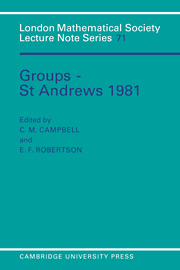Book contents
- Frontmatter
- Contents
- Preface
- Twenty-five years of Groups St Andrews Conferences
- Original Introduction
- 1 An elementary introduction to coset table methods in computational group theory
- 2 Applications of cohomology to the theory of groups
- 3 Groups with exponent four
- 4 The Schur multiplier: an elementary approach
- 5 A procedure for obtaining simplified defining relations for a subgroup
- 6 GLn and the automorphism groups of free metabelian groups and polynomial rings
- 7 Isoclinisms of group extensions and the Schur multiplicator
- 8 The maximal subgroups of the Chevalley group G2(4)
- 9 Generators and relations for the cohomology ring of Janko's first group in the first twenty one dimensions
- 10 The Burnside group of exponent 5 with two generators
- 11 The orientability of subgroups of plane groups
- 12 On groups with unbounded non-archimedean elements
- 13 An algorithm for the second derived factor group
- 14 Finiteness conditions and the word problem
- 15 Growth sequences relative to subgroups
- 16 On the centres of mapping class groups of surfaces
- 17 A glance at the early history of group rings
- 18 Units of group rings: a short survey
- 19 Subgroups of small cancellation groups: a survey
- 20 On the hopficity and related properties of some two-generator groups
- 21 The isomorphism problem and units in group rings of finite groups
- 22 On one-relator groups that are free products of two free groups with cyclic amalgamation
- 23 The algebraic structure of ℵ0-categorical groups
- 24 Abstracts
- 25 Addendum to: “An elementary introduction to coset table methods in computational group theory”
- 26 Addendum to: “Applications of cohomology to the theory of groups”
- 27 Addendum to: “Groups with exponent four”
- 28 Addendum to: “The Schur multiplier: an elementary approach”
6 - GLn and the automorphism groups of free metabelian groups and polynomial rings
Published online by Cambridge University Press: 07 September 2010
- Frontmatter
- Contents
- Preface
- Twenty-five years of Groups St Andrews Conferences
- Original Introduction
- 1 An elementary introduction to coset table methods in computational group theory
- 2 Applications of cohomology to the theory of groups
- 3 Groups with exponent four
- 4 The Schur multiplier: an elementary approach
- 5 A procedure for obtaining simplified defining relations for a subgroup
- 6 GLn and the automorphism groups of free metabelian groups and polynomial rings
- 7 Isoclinisms of group extensions and the Schur multiplicator
- 8 The maximal subgroups of the Chevalley group G2(4)
- 9 Generators and relations for the cohomology ring of Janko's first group in the first twenty one dimensions
- 10 The Burnside group of exponent 5 with two generators
- 11 The orientability of subgroups of plane groups
- 12 On groups with unbounded non-archimedean elements
- 13 An algorithm for the second derived factor group
- 14 Finiteness conditions and the word problem
- 15 Growth sequences relative to subgroups
- 16 On the centres of mapping class groups of surfaces
- 17 A glance at the early history of group rings
- 18 Units of group rings: a short survey
- 19 Subgroups of small cancellation groups: a survey
- 20 On the hopficity and related properties of some two-generator groups
- 21 The isomorphism problem and units in group rings of finite groups
- 22 On one-relator groups that are free products of two free groups with cyclic amalgamation
- 23 The algebraic structure of ℵ0-categorical groups
- 24 Abstracts
- 25 Addendum to: “An elementary introduction to coset table methods in computational group theory”
- 26 Addendum to: “Applications of cohomology to the theory of groups”
- 27 Addendum to: “Groups with exponent four”
- 28 Addendum to: “The Schur multiplier: an elementary approach”
Summary
INTRODUCTION
For an integer n ≥ 2, we consider the following three groups:
GLn-1(R), the group of invertible (n - 1) × (n - 1) matrices with entries in R = ℤ [x1, …,xm] or K[x1, …,xm+1], m ≥ 1, the polynomial ring over the integers ≥ or a field K.
Aut(M(n)), the group of automorphisms of the free metabelian groups M(n) = F(n)/F″(n) of rank n where F(n) is the free group of rank n and F″(n) its second derived group.
AutK(P(n)), the group of K-automorphisms of the polynomial ring P(n) = K[x1,…,xn] in n indeterminates over the field K.
AutK(P(n)), the group of K-automorphisms of the polynomial ring P(n) = K[x1,…,xn] in n indeterminates over the field K.
A study of these groups has split into three distinct phases corresponding to values n = 2, n = 3 and n ≥ 4. Our theme is that the three groups have many similar or analogous characteristics and should be considered as one and the same study.
Consider for example an immediate question confronting one in a study of these groups. What is a reasonable set of generators? More specifically, do any of these groups possess elements other than the obvious or tame ones? (See §2 for definitions). Apart from the case n = 3, evidence is pointing to the fact that these groups possess only tame elements. The exceptional case n = 3 is indeed very different from the cases n ≠ 3, as we shall see, but apparently similar for all three groups. We attempt to justify this apparent similarity in our explanations below.
- Type
- Chapter
- Information
- Groups - St Andrews 1981 , pp. 160 - 168Publisher: Cambridge University PressPrint publication year: 1982



